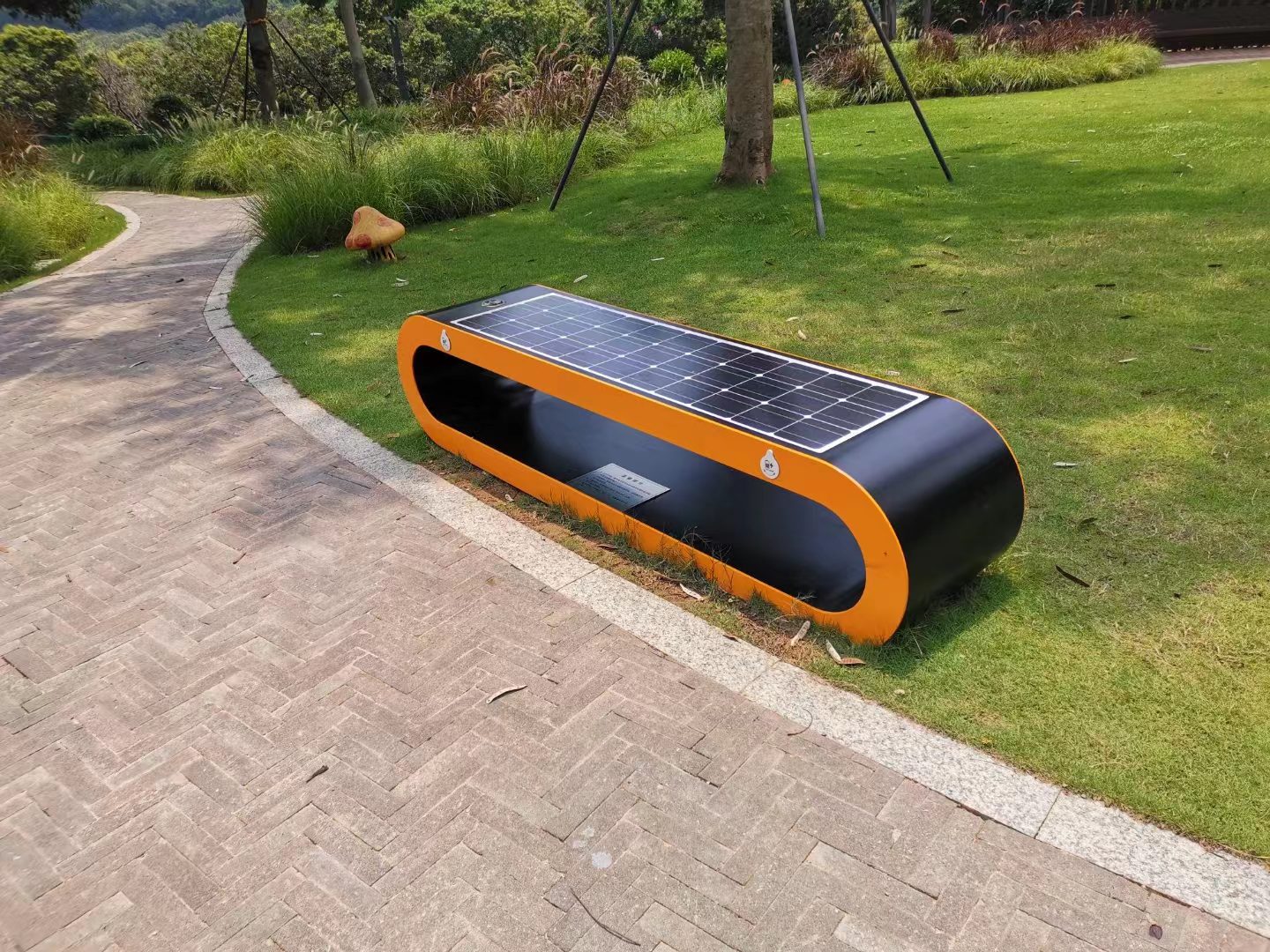Is there more to a bench than simply a seat? Imagine a bench that is accessible and welcoming to all people, one that can learn and change to meet the needs of its users. The issue then arises, how might these seats alter our perception of urban life? this is the era of smart benches, where technology meets urban comfort.
Smart benches can improve public space accessibility and diversity by addressing many demands. Modern benches with charging stations, Wi-Fi, weather information, and air quality sensors are convenient and accommodating for a variety of people, including those with mobility issues, the visually impaired, and anyone looking for a comfortable place to rest and recharge.
We’ll explore how smart benches change public speaking in the subsequent sections. We’ll examine how they boost accessibility, inclusiveness, safety, social inclusion, and civic involvement while meeting individual requirements. This article will reveal how these creative benches may make cities more inclusive, accessible, and connected.
How Do Smart Benches Improve Accessibility?
Mobile device charging stations
The capacity of solar benches to operate as mobile device charging stations is one of their most immediate and useful features. This seemingly basic characteristic significantly affects accessibility. Smartphones and tablets are often used by people with disabilities for a variety of tasks, including communication and information access. Smart benches guarantee that these people may remain connected and informed when in public places by providing charging possibilities.
Improved Mobility
Solar-powered smart benches with integrated lighting systems may make nighttime public places safer. For those with vision problems, who may need well-lit spaces to travel easily, this is especially advantageous. Additionally, solar-powered seats lessen the need for extra infrastructure, such as lamps, encouraging a clear atmosphere that is simpler for everyone to traverse.
Accessibility to Data
Wi-Fi connection is a common feature of smart benches, giving users free access to the internet. People who depend on the internet to obtain necessary services like healthcare services, online banking, or information on public transit may find this feature to be of particular use. It lowers obstacles to accessing information and services, improving accessibility for everyone.
How Do Smart Benches Promote Inclusivity?
Seating for Everyone
For certain people, particularly those with mobility challenges, traditional park seats might be unpleasant or unusable. Ergonomic design aspects are often used in smart benches to make them more comfortable and usable by a larger variety of users. Everyone benefits from this inclusive seating concept, including the elderly and those who have just sustained injuries.
Universal Design
Usually, universal accessibility is taken into consideration while designing smart benches. They follow the universal design principles, which put an emphasis on making settings usable by individuals of all abilities. The benches are more inclusive thanks to features like backrests, armrests, and surfaces that are slip-resistant.
An intuitive interface
Smart benches include intuitive user interfaces that are simple for people of all abilities to utilize. For those who have difficulties with their vision or fine motor skills, touchscreens and user interfaces with big, immediately recognizable symbols might be very helpful. Additionally, some smart benches include smartphone applications that allow users to manage many aspects of their experience.
How Can Smart Benches Enhance Safety in Public Spaces?
Smart seats may significantly contribute to enhancing public safety, which is a major concern:
Lighting
Safety in public areas is improved by smart seats with built-in lighting systems, especially at night and throughout the evening hours. Areas that are well-lit discourage criminal activity and allow people to move around more confidently. For those with impairments, who may need more lights to travel safely, this is particularly crucial.
Emergency Services
Some smart benches come with features like emergency buttons that let users ask for help in case of an emergency. For those with impairments or medical issues that may need for rapid treatment, this may be a lifeline.
Security and surveillance
Additionally, smart seats may have sensors or cameras for keeping an eye on the area. This not only discourages possible criminal activity but also makes sure that everyone may feel secure and welcome in public areas.
How Can Smart Benches Encourage Social Inclusion?
Smart benches may promote social inclusion in a number of ways. Public places are centres for social interaction.
Charging stations for interpersonal communication
Smart benches with charging connections encourage people to sit and interact. In public places, friends and family may congregate, charge their gadgets, and spend valuable time together. This promotes inclusion and a feeling of community.
Wi-Fi Accessibility
Smart benches’ free Wi-Fi encourages online social engagement by letting users connect with friends and family, take part in virtual meetings, or even do remote work or study. This is especially advantageous for those who may encounter physical obstacles while attending live events.
Community Alerts and Events
Wi-Fi enabled smart seats may be used to broadcast information about neighbourhood activities and projects. This promotes a feeling of community belonging by keeping disabled people informed about accessible activities and services.
How Do Smart Benches Address Specific Needs?
Smart seats are adaptable and may be tailored to meet certain community needs:
Multilingual interfaces
Multilingual interfaces on smart benches may make it easier for those who don’t speak English very well to access information and services. This makes sure that accessibility is not hampered by linguistic problems.
Features to Make Accessible
Smart benches that may be customized to meet unique requirements by providing tactile markers, audio announcements, or braille interfaces for those with hearing or vision impairments. These attributes contribute to a more welcoming workplace.
Support for Well-Being and Health
Some smart benches provide amenities that support health and wellbeing, such as air quality monitors and water bottle refilling stations. All people may benefit from these ingredients, but those with health issues may find them to be especially useful.
How Do Smart Benches Encourage Civic Engagement?
Smart seats may support civic involvement in a number of ways in public areas, which are suitable venues for it:
Information Centers
SolaraNook Smart benches may act as information centres by connecting users to local news, official notifications, and neighbourhood projects. People are encouraged to become more involved in civic life as a result of this.
Polling Places
During elections, innovative smart seats may also serve as portable voting booths, facilitating the exercise of everyone’s right to vote. An inclusive democracy is supported by this.
Community Feedback and Surveys
Smart benches have integrated touchscreens or mobile applications that may be used to poll the local population and get their opinions on a range of topics. Individuals are given more freedom to express their thoughts and worries as a result, which helps the group make better decisions.
Are There Any Limitations to Smart Benches?
While smart benches have several benefits, it’s important to take into account their drawbacks as well:
Cost
Since installing smart seats might be expensive initially, some governments may run into financial difficulties. However, the costs may eventually be covered by the energy savings and possible money from sponsorships or adverts.
Maintenance
Complex smart seat features could need more upkeep than basic benches. Local governments may find this to be a hardship, but with careful planning and maintenance spending, this problem may be lessened.
Technology Accessibility
Not everyone feels at ease or is acquainted with technology. Smart benches must have accessible user interfaces and clear instructions since some people may find them difficult to use.
How Can Communities Implement Smart Benches?
Communities may install smart benches effectively by taking the following actions:
Needs Evaluation
Communities should begin by determining their unique requirements and objectives. Which characteristics are most important to their population? Surveys and stakeholder consultations may provide insightful information.
Funding and Budgeting
Establish the spending limit necessary for the installation and maintenance of smart benches. Look into public-private partnerships, grants, and other financing alternatives.
Pilot Projects
In order to assess their effect and user feedback, think of launching a few smart seats in certain locations. This may aid in adjusting the implementation plan.
Accessibility Education
To guarantee that those with impairments or others who are less tech-savvy can use the smart benches to their full potential, provide training and assistance.
Consistent Maintenance
In order to maintain the smart benches in excellent working order, create a maintenance program. Regular inspections and prompt repairs are crucial.
Community Participation
To guarantee that the smart benches satisfy their requirements, aggressively solicit input from the community and include them in the decision-making process.
What’s the Future of Smart Benches?
With continual improvements and breakthroughs, smart benches have a promising future. Possible developments include the following:
Improved Accessibility Features
Smart benches will keep enhancing their accessibility features to better serve a wider variety of people with various requirements.
Compatibility with smart cities
Smart benches will probably play a key role in broader smart city programs, making cities safer, more effective, and more accessible.
Sustainability
Smart benches will become even more eco-friendly with the incorporation of sustainable technology, such as more effective solar panels and energy storage devices.
Conclusion
A possible method for enhancing inclusiveness and accessibility in public areas is the use of smart benches. These creative benches meet the varied demands of the community with features like device charging, Wi-Fi connection, universal design, and environmental sustainability. They improve public areas’ accessibility and friendliness for everyone, social inclusion, and civic participation. Even if there are difficulties with cost and upkeep, proper planning and community engagement can guarantee the success of the adoption of smart seats. These seats will likely be essential in determining how inclusive public spaces will develop in the future as they continue to develop.































